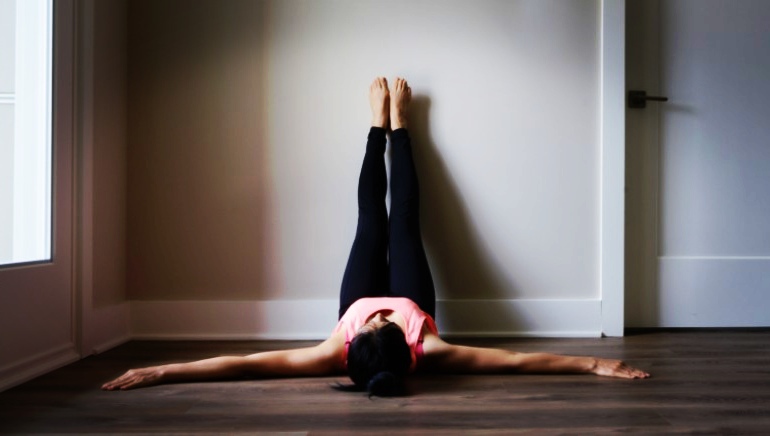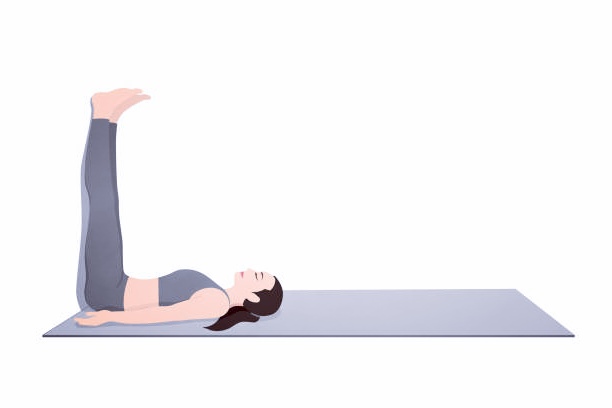Legs up the wall for 20 minutes

Legs up the wall is a yoga pose where you lie on your back and place your legs up against a wall, so your body forms an L shape. This pose is considered to be a restorative yoga posture, and it is often recommended to reduce stress and anxiety, improve circulation, and aid in digestion. However, can it also help with weight loss? In this article, we will explore this question and provide information on how to do legs up the wall and the potential benefits.
How to Do Legs Up the Wall
To do legs up the wall, you will need a clear wall space and a comfortable mat or blanket to lie on. Here are the steps to follow:
Find a clear wall space and sit next to it with your knees bent, facing the wall.
Lie on your back and swing your legs up against the wall so that your body forms an L shape. Your buttocks should be as close to the wall as possible.
Place your arms at your sides, palms up, and close your eyes. Stay in this position for 20 minutes.
To come out of the pose, gently slide your legs down the wall and roll over onto one side, staying there for a few breaths before sitting up.
It is important to note that if you have any medical conditions or injuries, you should consult with a healthcare professional before attempting this pose. Additionally, it is recommended that you do this pose on an empty stomach.
Potential Benefits of Legs Up the Wall
Now that we know how to do legs up the wall, let’s explore the potential benefits:
Relieves Stress and Anxiety: Legs up the wall is a restorative yoga posture that helps to reduce stress and anxiety by promoting relaxation. When you lie with your legs up the wall, you activate the parasympathetic nervous system, which is responsible for the “rest and digest” response in the body. This can help to reduce the levels of cortisol, the stress hormone, in your body.
Improves Circulation: Lying with your legs up the wall can help to improve blood flow to your legs and lower body. This can be particularly beneficial if you spend a lot of time sitting or standing, as it can help to prevent blood from pooling in your legs and feet.
Aids in Digestion: Legs up the wall can help to stimulate the digestive system by promoting the flow of blood to the digestive organs. This can aid in the absorption of nutrients and help to prevent constipation.
Reduces Swelling: Lying with your legs up the wall can help to reduce swelling in your feet and ankles, particularly if you have been standing or walking for a long period.
Improves Sleep: Legs up the wall can be a great way to unwind before bed and promote better sleep. Promoting relaxation and reducing stress, it can help you fall asleep more easily and sleep more deeply.
Can Legs Up the Wall Help with Weight Loss?
While legs up the wall have many potential benefits, it is not a weight loss technique. Weight loss is a complex process that involves a combination of factors, including diet, exercise, and lifestyle habits. To lose weight, you need to create a calorie deficit, which means consuming fewer calories than you burn.
That being said, practicing legs up the wall as part of a regular yoga or exercise routine can help to support weight loss by promoting relaxation and reducing stress. When you are stressed, your body produces cortisol, which can increase appetite and promote the storage of fat. By reducing stress, you may be less likely to overeat or reach for unhealthy snacks.
Additionally, by improving circulation and aiding in digestion, legs up the wall can help to promote healthy metabolism, which is important for weight loss.
While it’s many benefits for legs up the wall but another hand it some disadvantages are also for legs up the wall
While legs up the wall are generally considered safe and beneficial purposes pose for most people, there are some potential disadvantages or precautions to keep in mind:
Inverted Position: Legs up the wall is an inverted poses, which means that your heart is above your head. While this can be beneficial for improving circulation and reducing swelling, it can also put extra strain on your cardiovascular system. If you have any heart or blood pressure issues, you should talk to your doctor before attempting this pose.
Neck Pain: If you have any neck issues, you may find that lying with your head on the ground and your legs up against the wall can be uncomfortable or painful. In this case, you can use a rolled-up blanket or pillow under your head for support.
Leg Discomfort: Lying with your legs up against the wall for an extended period can sometimes cause discomfort or numbness in your legs. To avoid this, you can try bending your knees slightly or placing a small pillow or blanket under your lower back for support.
Eye Pressure: Some people may experience discomfort or pressure in their eyes when lying with their heads on the ground and their legs up against the wall. If you experience this, you can place an eye pillow or towel over your eyes for additional support.
Contraindications: While legs up the wall are generally safe for most people, there are some medical conditions or injuries that may make this pose contraindicated. These include glaucoma, hypertension, spinal injuries, and certain types of hernias. If you have any medical concerns or injuries, it is important to talk to your healthcare provider before attempting this pose.
In conclusion, legs up the wall is a simple and effective yoga pose that can offer many potential benefits, including stress relief, improved circulation, and better sleep. However, as with any yoga pose or exercise, it is important to listen to your body and make any necessary modifications or adjustments to avoid discomfort or injury. If you have any medical concerns or are new to yoga, it is always a good idea to consult with a qualified yoga instructor or healthcare provider to ensure that you are practicing safely and effectively.
here some common questions about legs up the wall
Is it OK to lift your legs every day?
Whether it is okay to lift your legs every day depends on various factors such as your overall health, fitness level, and the type and intensity of the exercise you are doing. If you are performing legs up the wall, which is a gentle and restorative yoga pose, it is generally safe to do it every day.
Doing legs up the wall for 10-20 minutes every day can be a great way to reduce stress, improve circulation, and promote relaxation. However, it is important to listen to your body and not overdo it. If you experience any discomfort, pain, or other symptoms while doing the pose, you should stop immediately and rest.
On the other hand, if you are performing more intense leg exercises such as weightlifting or running, it may not be advisable to do them every day. Your muscles need time to rest and recover between workouts to avoid injury and achieve optimal results.
In general, experts recommend incorporating a mix of different types of exercises into your routine, including cardio, strength training, and flexibility work. This can help you achieve a well-rounded fitness program and prevent boredom or burnout from doing the same exercises every day.
Ultimately, the frequency and intensity of your leg exercises should be tailored to your individual needs and goals. If you are new to exercise or have any medical concerns, it is always a good idea to consult with a qualified healthcare provider or fitness professional before starting a new exercise program.
Do legs up the wall help cellulite?
Legs up the wall is a gentle yoga pose that can offer many potential benefits, including reducing stress and improving circulation. While it is not a specific remedy for cellulite, some experts believe that improved circulation can help reduce the appearance of cellulite.
Cellulite is a condition where the skin appears dimpled or lumpy, typically on the thighs, buttocks, or hips. It is caused by underlying fat deposits that push through the connective tissue beneath the skin. While there is no cure for cellulite, some lifestyle changes and treatments may help reduce its appearance.
Improved circulation is one potential way to reduce the appearance of cellulite. When blood and lymphatic fluid flow more freely through the body, it can help to flush out toxins and improve the overall health and appearance of the skin. Legs up the wall can help improve circulation by reducing swelling and promoting relaxation.
In addition to legs up the wall, other yoga poses that may help improve circulation and reduce the appearance of cellulite include:
Downward-facing dog
Bridge pose
Warrior II
Chair pose
Triangle pose
It is important to note that while these poses may be beneficial for improving circulation and reducing the appearance of cellulite, they should be practiced as part of a well-rounded fitness program that includes cardio, strength training, and other types of exercise. In addition, diet, hydration, and maintaining a healthy weight may also play a role in reducing the appearance of cellulite.
In conclusion, while legs up the wall are not a specific remedy for cellulite, they can help improve circulation and promote relaxation, which may be beneficial for reducing the appearance of cellulite over time. However, as with any exercise or lifestyle change, it is important to listen to your body and make any necessary modifications or adjustments to avoid discomfort or injury. If you have any medical concerns or are new to yoga, it is always a good idea to consult with a qualified yoga instructor or healthcare provider to ensure that you are practicing safely and effectively.
Can we do legs up the wall after eating?
It is generally safe to do legs up the wall after eating, but it is recommended to wait for at least 30 minutes after a meal before performing any exercise, including yoga poses like legs up the wall. This is because digestion requires a lot of energy and blood flow in the stomach and digestive system, and exercising too soon after eating may interfere with this process and cause discomfort or other digestive issues.
When you eat, your body sends extra blood to the digestive system to help break down food and absorb nutrients. If you exercise too soon after eating, your body may redirect blood flow away from the digestive system to the muscles that are working, which can slow down digestion and cause stomach discomfort, bloating, or cramping.
Waiting for 30 minutes to an hour after eating before performing legs up the wall or any other exercise can help ensure that your digestive system has had enough time to process the food and that blood flow has returned to normal levels. This can help reduce the risk of digestive discomfort and help you get the most benefit from your yoga practice.
In addition to waiting for 30 minutes after eating, it is also important to stay hydrated and avoid overeating before practicing yoga or any other exercise. Eating a light meal or snack before yoga can help provide energy for your practice, but overeating or consuming heavy, high-fat, or spicy foods can make it more difficult to perform yoga poses comfortably.
Ultimately, the best approach is to listen to your body and make any necessary adjustments to your yoga practice based on how you feel. If you experience any discomfort or digestive issues during or after your legs up the wall or any other yoga pose, it is important to rest and seek guidance from a qualified yoga instructor or healthcare provider.
Why do legs up the wall hurt?
Legs up the wall is generally a gentle and relaxing yoga pose, but it can cause discomfort or pain in some people if it is not performed correctly or if there are underlying health issues.
Here are some common reasons why legs up the wall might cause pain:
Tight or tense muscles: If your muscles are tight or tense, it can make it more difficult to get into the proper alignment for the legs up the wall. This can cause discomfort or pain in the legs, hips, or lower back. To avoid this, try to relax your muscles and take slow, deep breaths as you hold the pose.
Improper alignment: If you are not aligned properly in the pose, it can put pressure on the joints or muscles in your legs, hips, or lower back. To avoid this, make sure your hips are close to the wall and your legs are straight and aligned with your hips. You may need to use a bolster or blanket under your hips to achieve the proper alignment.
Injuries or health issues: If you have any injuries or health issues, such as sciatica, varicose veins, or hip pain, it may be uncomfortable or painful to perform legs up the wall. It is important to listen to your body and modify the pose as needed or seek guidance from a qualified healthcare provider or yoga instructor.
Overexertion: If you push yourself too hard in the pose, it can cause pain or discomfort. It is important to start slowly and gradually increase the amount of time you spend in the pose. If you feel any discomfort or pain, come out of the pose and rest.
If you experience pain or discomfort during legs up the wall, it is important to listen to your body and modify the pose as needed or seek guidance from a qualified healthcare provider or yoga instructor. They can help you identify any underlying issues and suggest modifications or alternative poses that may be more comfortable for you.

















